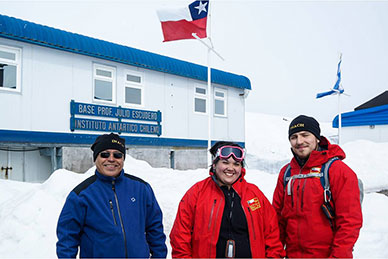- Through a Fondecyt Project led by Dr. Gustavo Zúñiga, a research team of Universidad de Santiago is carrying out measurements of the mosses at the Collins Glacier and the Ardley Peninsula, in order to analyze the impact of global warming on these populations and identify their tolerance mechanisms to resist environmental changes.
Dr. Gustavo Zúñiga, researcher at Universidad de Santiago; Marisol Pizarro, a graduate student of the Biotechnology PhD program of the Faculty of Chemistry and Biology, and Gustavo Zúñiga-Líbano, an undergraduate student of the Biotechnology Engineering Program of the Faculty of Engineering, are now at the “Profesor Julio Escudero” base of the Chilean Antarctic Institute (INACH, in Spanish) studying the impact of global warming on Antarctic mosses in the context of the Fondecyt Project "Metabolomic responses of the Antarctic mosses Sanionia uncinata and Polytrichastrum alpinum to global warming".
While the researchers are in the Antarctica, they aim to establish a baseline with regards to the effect that global warming is having on the region and, particularly, to identify the environmental tolerance mechanisms of the Sanionia uncinata and Polytrichastrum alpinum mosses. In order to reach these goals, the study involves collecting samples and measuring the environmental variables in the Collins Glacier and the Ardley Peninsula.
“We must consider that the Antarctic Peninsula has been one of the areas most affected by global warming; in spite of this, there are no studies up to date regarding the response to this phenomenon at a molecular level and there are no studies that correlate the stress conditions that these species are enduring in the Antarctica, either,” Dr. Zúñiga explained. The study aims to describe the physiological and molecular changes caused by the increase in temperature, UVB radiation and the availability of water for these mosses.
The members of the Plant Physiology and Biotechnology Laboratory of the Department of Biology at the Faculty of Chemistry and Biology; Hans Köhler, a graduate student of the Biotechnology PhD program, and Dr. Rodrigo A. Contreras- who traveled in December to the Unión Glacier polar scientific station to work in the project by studying the lichens of the area– have also contributed to this study.



